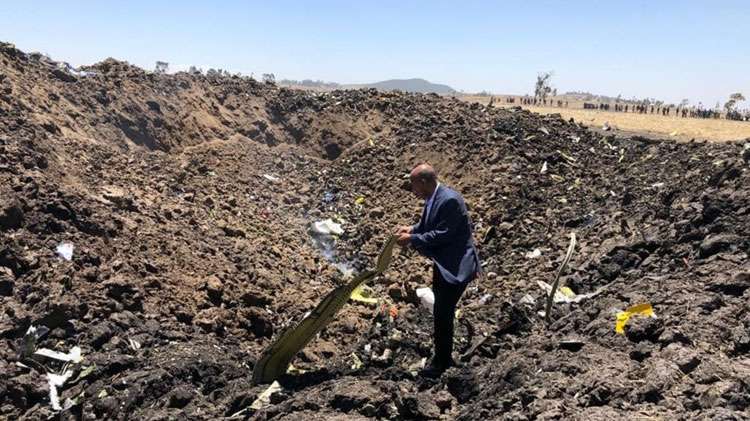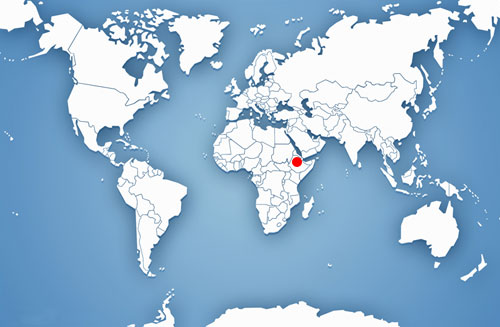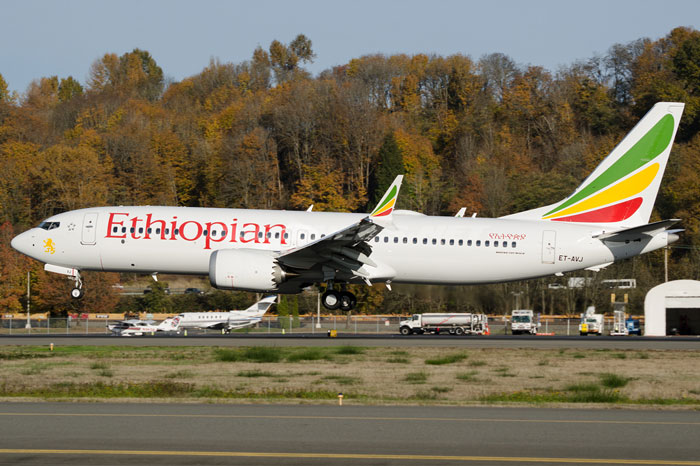Ethiopian Airlines Boeing 737-800MAX plane crash
Bishoftu, Ethiopia

Updated on
 The Boeing 737-800 MAX operated by Ethiopian Airline took off from Addis Ababa, Ethiopia, for a passenger flight to Nairobi, Kenya. 149 passengers and 8 crewmembers were onboard. The plane crashed shortly after takeoff. All the 157 people onboard were killed.
The Boeing 737-800 MAX operated by Ethiopian Airline took off from Addis Ababa, Ethiopia, for a passenger flight to Nairobi, Kenya. 149 passengers and 8 crewmembers were onboard. The plane crashed shortly after takeoff. All the 157 people onboard were killed.
The plane took off from Addis Ababa airport. The airport altitude is 7600 ft (2300 meters). The plane climb was unstable, and the pilot reported difficulties to Air Traffic Controllers and requested to return to Addis Ababa. The Boeing 737 levelled off at around 9000 ft (2700 meters) and crashed seconds later. Radar contacts were lost 6 minutes after takeoff, at around 20 NM (35 km) South-East of Addis Ababa. The terrain elevation at the point where the radar contact was lost is around 8000 ft (2400 meters), and is in a mountainous area. The crash scene is small, and is littered with small debris, which is consistent with a steep dive. Weather conditions at the time of the accident were good, with a good visibility and few clouds.
The Boeing 737 MAX was very recent: it had been delivered to Ethiopian Airline in November 2018 (4 months before the accident).
The Boeing 737 MAX is a new generation of the Boeing 737. It is the second time in less than six months that a Boeing 737 MAX has crashed within minutes of takeoff, after a new Lion Air Boeing 737 MAX flight went down over the Java Sea in October 2018, killing 189 people. On Mar 11th 2019, Ethiopian Airlines but also a number of other airlines decided to stop using their Boeing 737 MAX until the cause of both crashes is clarified. There are approximately 350 Boeing 737 Max 8 aircraft in operation worldwide, being flown by 54 operators, according to the US Federal Aviation Administration (FAA).
On March 12th 2019, the European Aviation Safety Agency (EASA) closed the airspace across Europe for any Boeing 737 MAX operation. Number of other countries have also suspended Boeing 737 MAX operations.
On March 12th 2019, Boeing issued a release with respect to the two recent Boeing 737 MAX crashes: « For the past several months and in the aftermath of Lion Air Flight 610, Boeing has been developing a flight control software enhancement for the 737 MAX, designed to make an already safe aircraft even safer. This includes updates to the Maneuvering Characteristics Augmentation System (MCAS) flight control law, pilot displays, operation manuals and crew training. The enhanced flight control law incorporates angle of attack (AOA) inputs, limits stabilizer trim commands in response to an erroneous angle of attack reading, and provides a limit to the stabilizer command in order to retain elevator authority. » The FAA stated it anticipates mandating this software enhancement with an Airworthiness Directive (AD) no later than April.
On March 13th 2019, the Federal Aviation Administration (FAA) has decided to prohibit Boeing 737 MAX aircraft to operate in US airspace. The same day, the Canada also restricted the use of Boeing 737 MAX aircraft in Canadian Airspace.
On March 13th 2019, the President of the United States signed an executive order effectively grounding all Boeing 737 MAX aircraft around the globe. Aircraft currently flying is permitted to continue to its destination, thereafter the aircraft will remain on the ground.
On March 17th 2019, and further to the readout of the Cockpit Voice Recorder and Flight Data Recorder, it has been established the cause of the crash is similar to the Lion Air Flight 610 in Indonesia.
On Apr 4th 2019, the Ethiopia's Civil Aviation Authority (ECAA) released the following note:
« Preliminary findings on ET 302 crash:
1. Aircraft’s airworthiness was certified;
2. The crew were capable of flying and followed Boeing’s procedures;
3. Take off appeared normal;
4. Crew followed all procedures, but was unable to control the aircraft. »
Immediately after the ECAA statement, Ethiopian Airlines has stated : « […] The preliminary report clearly showed that the Ethiopian Airlines Pilots who were commanding Flight ET 302/10 March have followed the Boeing recommended and FAA approved emergency procedures to handle the most difficult emergency situation created on the airplane. Despite their hard work and full compliance with the emergency procedures, it was very unfortunate that they could not recover the airplane from the persistence of nose diving. […] »
The same day, Boeing has commented : « […] The full details of what happened in the two accidents will be issued by the government authorities in the final reports, but, with the release of the preliminary report of the Ethiopian Airlines Flight 302 accident investigation, it’s apparent that in both flights the Maneuvering Characteristics Augmentation System, known as MCAS, activated in response to erroneous angle of attack information. […] As pilots have told us, erroneous activation of the MCAS function can add to what is already a high workload environment. […] »
This accident is the 22nd worst plane crash since year 2000 in terms of the number of combined onboard and ground fatalities. Watch here the list of the worst aircraft crashes since year 2000.



